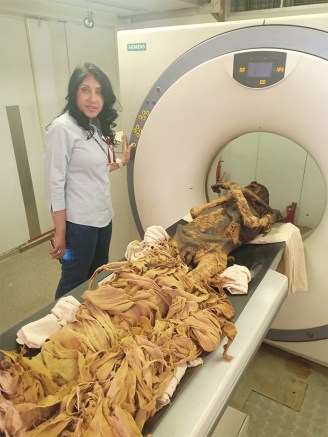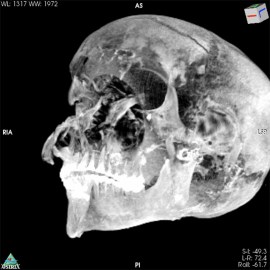
CT scanning of the mummy of Pharaoh Seqenenre
revealed new information about the head injuries that caused his death and the circumstances that surrounded it. [Image: Sahar N Saleem]
Pharaoh Seqenenre-Taa-II (c.1558–1553 BC) ruled southern Egypt at the end of the 17th Dynasty, during a time when the northern part of the country was controlled by a group called the Hyksos, who originated in Asia. Historical records indicate that there was ongoing tension between Seqenenre and the Hyksos, and it is believed that he died trying to overthrow them, but the details of his death have remained uncertain until now.

The mummy of Pharaoh Seqenenre was discovered in 1881, and multiple physical examinations in the 1880s and in later years, as well as an X-ray study in the 1960s, have attempted to establish the events surrounding his death. New research published in Frontiers in Medicine (https://doi.org/10.3389/fmed.2021.637527) has now used computed tomography (CT) scans to shed further light on the subject.
Detailed study of the injuries to Seqenenre’s head has indicated that they were caused by several different weapons, suggesting that he was killed by multiple attackers, perhaps during some kind of ceremonial execution. Five different Hyksos weapons from this period were examined and appear to match the morphology of the wounds, supporting the theory that he died in conflict with the Hyksos.

The study has also confirmed a lack of defensive wounds on his arms, as well as evidence that they were bent in a way which indicates that they were tied at the wrists at the time of death. It is therefore proposed that Seqenenre had been captured by the enemy before being killed on the battlefield, ruling out some of the theories that had previously been proposed, such as a palace conspiracy to kill him in his sleep.

The CT scan of Pharaoh Seqenenre’s skull. [Image: Sahar N Saleem]
The CT scans also challenge earlier ideas about the mummification process, which was originally suggested to have been carried out hastily in a temporary setting. However, this study identified previously unnoticed injuries on Seqenenre’s head, which the embalmers had skilfully managed to conceal, in addition to other evidence which indicates that considerable efforts had been made to mummify him properly. The scans revealed that Seqenenre’s brain had shifted to the left side of his skull, too, indicating that his body was left lying on this side, either on the battlefield or during transport to the Theban royal mummification workshop, for long enough for decomposition to begin before the mummification process could be started, which would explain the greasy bandages and bad odour of the mummy.

CT scans have been used to study several well-known Egyptian pharaohs, including Tutankhamun, Ramesses III, and Hatshepsut, but the analysis of Seqenenre’s mummy offers a fascinating insight into a pivotal point in Egyptian history, uncovering the details surrounding his violent death, which indirectly led to the reunification of Egypt and the start of the New Kingdom.
This article appeared in issue 106 of Current World Archaeology. Click here for more information about subscribing to the magazine.